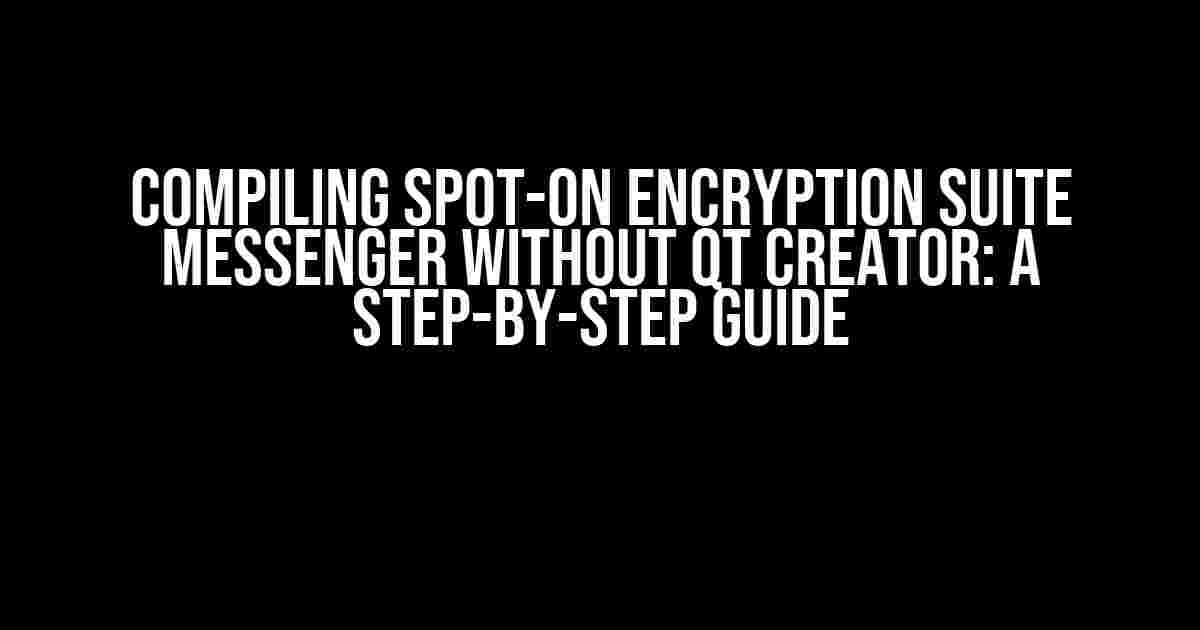Are you tired of relying on third-party messaging apps that compromise your privacy? Do you want to take control of your online communications? Look no further! In this article, we’ll walk you through the process of compiling Spot-On Encryption Suite Messenger without Qt Creator, giving you a secure and private messaging solution.
- What is Spot-On Encryption Suite Messenger?
- Why Compile without Qt Creator?
- Prerequisites
- Step 1: Clone the Repository
- Step 2: Change into the Repository Directory
- Step 3: Prepare the Build Environment
- Step 4: Configure the Build with CMake
- Step 5: Build the Messenger
- Step 6: Install the Messenger
- Troubleshooting Common Issues
- Conclusion
What is Spot-On Encryption Suite Messenger?
Spot-On Encryption Suite Messenger is a free and open-source messaging app that prioritizes user privacy and security. Developed by a team of experts, this encryption suite uses advanced cryptographic techniques to protect your messages, voice, and video calls. By compiling and using Spot-On Encryption Suite Messenger, you’ll have a secure and reliable means of communication, free from prying eyes.
Why Compile without Qt Creator?
Qt Creator is a popular integrated development environment (IDE) for building Qt-based applications. While it’s an excellent tool, some users may not have access to Qt Creator or prefer to compile Spot-On Encryption Suite Messenger manually. In this article, we’ll demonstrate how to compile the messenger without Qt Creator, ensuring you have full control over the compilation process.
Prerequisites
Before we dive into the compilation process, make sure you have the following prerequisites installed on your system:
- Git (for cloning the repository)
- C++ compiler (GCC or Clang)
- Qt 5.15 or later (for building the GUI)
- CMake 3.10 or later (for generating build files)
- A C++ IDE or text editor (optional)
Step 1: Clone the Repository
Open your terminal or command prompt and clone the Spot-On Encryption Suite Messenger repository using Git:
git clone https://github.com/spot-on-encryption/Spot-On-Encryption-Suite-Messenger.gitThis will download the entire repository to a new directory called Spot-On-Encryption-Suite-Messenger.
Step 2: Change into the Repository Directory
Navigate into the cloned repository directory:
cd Spot-On-Encryption-Suite-MessengerStep 3: Prepare the Build Environment
Create a new directory for building the messenger and navigate into it:
mkdir build
cd buildThis will keep your build files separate from the source code.
Step 4: Configure the Build with CMake
Use CMake to generate build files for your system:
cmake ..This command tells CMake to generate build files for the Spot-On Encryption Suite Messenger project.
Step 5: Build the Messenger
Use your C++ compiler to build the messenger:
make -j8This command compiles the Spot-On Encryption Suite Messenger using 8 parallel jobs. You can adjust the number of jobs according to your system’s capabilities.
Step 6: Install the Messenger
Once the build process is complete, install the messenger:
make installThis command installs the Spot-On Encryption Suite Messenger to your system.
Troubleshooting Common Issues
During the compilation process, you may encounter some common issues. Here are some solutions to help you overcome them:
| Error | Solution |
|---|---|
| CMake error: Qt 5.15 or later not found | Install Qt 5.15 or later and ensure it’s in your system’s PATH |
| Compiler error: Unknown type ‘QByteArray’ | Check that you’ve installed Qt 5.15 or later and included the Qt headers in your project |
| Linker error: undefined reference to ‘QSslSocket’ | Ensure that Qt’s SSL module is installed and linked correctly |
Conclusion
Compiling Spot-On Encryption Suite Messenger without Qt Creator is a straightforward process that requires some basic knowledge of C++ development and command-line interfaces. By following these steps, you’ll have a secure and private messaging app that protects your online communications. Remember to always prioritize your privacy and security online.
Additional Resources
If you need further assistance or want to contribute to the Spot-On Encryption Suite Messenger project, check out the following resources:
- Spot-On Encryption Suite Messenger GitHub Repository
- Spot-On Encryption Suite Documentation
- Qt Licensing Information
Happy compiling, and remember to stay secure online!
Note: This article is for educational purposes only, and you should always ensure that you have the necessary permissions and licenses to compile and use the Spot-On Encryption Suite Messenger.
Frequently Asked Question
Get ready to crack the code! Here are the answers to your burning questions about compiling Spot-On Encryption Suite Messenger without Qt Creator.
Q1: What are the system requirements for compiling Spot-On Encryption Suite Messenger?
To compile Spot-On Encryption Suite Messenger, you’ll need a 64-bit system with at least 4GB of RAM, a multi-core processor, and a Linux or macOS operating system. Additionally, you’ll need to install the required dependencies such as CMake, GCC, and OpenSSL.
Q2: How do I download the source code for Spot-On Encryption Suite Messenger?
You can download the source code for Spot-On Encryption Suite Messenger from the official GitHub repository using the command `git clone https://github.com/Spot-On-Encryption-Suite/messenger.git`.
Q3: What is the command to configure the build process for Spot-On Encryption Suite Messenger?
To configure the build process, navigate to the source code directory and run the command `cmake .` (note the dot at the end). This will generate the necessary build files for your system.
Q4: How do I compile Spot-On Encryption Suite Messenger without Qt Creator?
After configuring the build process, you can compile Spot-On Encryption Suite Messenger using the command `cmake –build .` (again, note the dot at the end). This will start the compilation process, and you’ll see the messenger executable being built.
Q5: What if I encounter errors during the compilation process?
Don’t panic! If you encounter errors, check the error message for clues. Make sure you have all the required dependencies installed, and try running the command `cmake .` again. If the issue persists, you can try cleaning the build directory with `rm -rf CMakeCache.txt` and then re-running the configuration and build commands.
